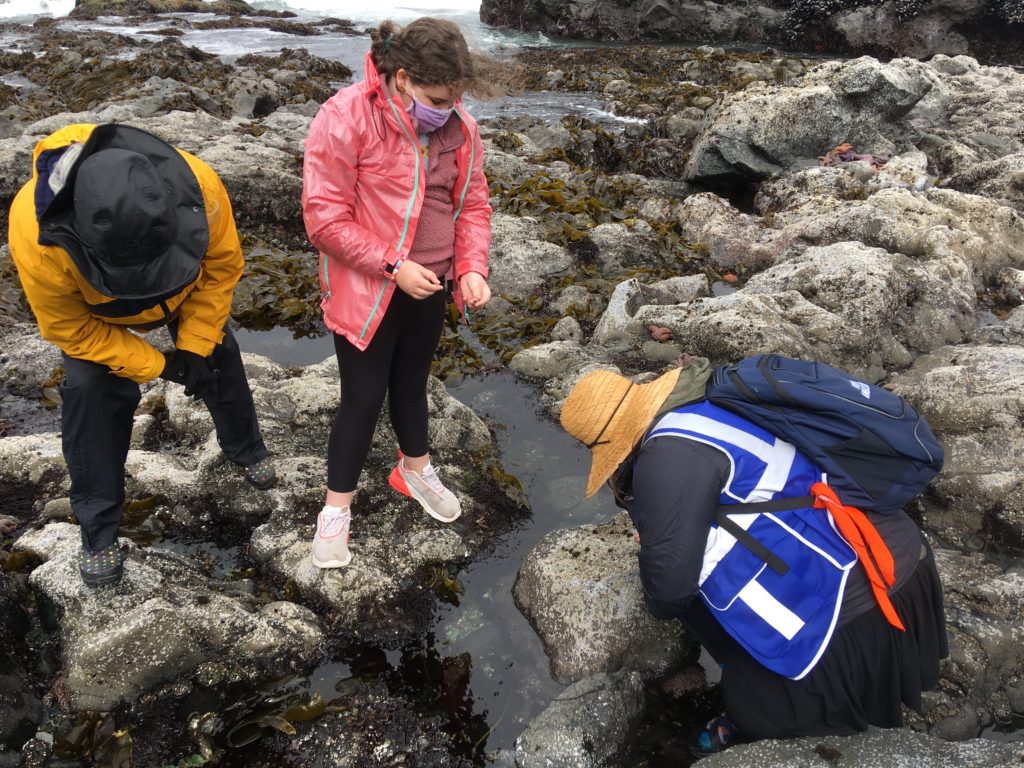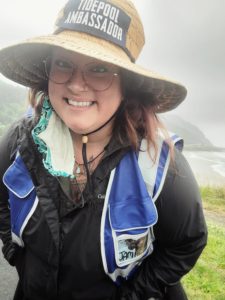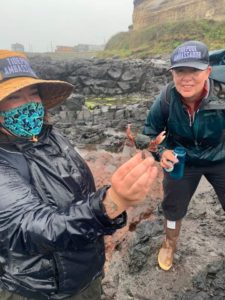
By DANA TIMS/YachatsNews.com
Jamie Kish has a quick word for anyone who glances at an Oregon coast tidepool at low tide and comes away thinking nothing much is going on.
“For every single occupant of that tidepool, low tides are actually an incredibly tumultuous time,” Kish said. “Your entire house drains and all of a sudden predators can see you. For the marine animals living there it’s a time of pure chaos, fear and survival to make it through the next four or five hours so they can breed, exist and expand again.”

Kish, a Yachats resident, should know. She has spent decades working in and researching ocean environments, including long stints in vaunted aquariums around the world.
Now, she is one of two hired contractors helping guide a new Tidepool Ambassadors program – an effort aimed both at illuminating the marvels of tidepools and letting people know how to move safely among them.
“The rocky coast of the Cape Perpetua Marine Reserve is unlike anyplace I’ve experienced so far,” Kish said. “For me, this is just a dream scenario.”
The ambassadors program initially was scheduled to launch last year. Covid-19, however, put things on hold until now, when visitors since Memorial Day have been getting guided, low-tide tours of tidepools at Yachats State Park and Bob Creek Wayside, six miles south of Yachats.
The Newport-based Surfrider Foundation helped lead the charge last year, when it brought together state parks officials, non-profit groups and other resource managers to craft a new program focusing on tidepools.
The group remains hopeful that in coming years the Tidepool Ambassadors program will get a big boost in the form of a full partnership with a willing state agency. For now, it is relying on a $15,000 grant from the Oregon Coast Visitors Association. That money will be split evenly between the two formally designated marine reserves involved – Cape Perpetua and Cape Falcon.
In addition to Kish and Elizabeth Lemhouse, Kish’s contractor counterpart, the program features about a dozen volunteers trained in marine reserves, tidepool ecology, safety measures (“Don’t turn your back on the ocean!”), and conservation.
The tours, which run through Aug. 23, are limited to five people and require an RSVP booking.

“We want to keep the groups really small so we don’t overrun the tidepools,” said Tara DuBois, communications coordinator for the Cape Perpetua Collaborative.
Program volunteers, also wearing distinctive blue hats and backpacks, will be available at both spots to take questions from other individuals or small groups who just show up and have questions about tidepools, she said.
Charlie Plybon, Oregon policy manager for Surfrider Foundation, said requests for tours have been impressive in the early going. He is equally hopeful that the educational component of the program will pay off for both visitors and tidepool occupants.
“Tidepools are the star of the Oregon shoreline,” he said. “But, coastwide, our goal is to create both awareness and safety of what’s going on there.”
The mix of those taking part in Kish’s tours thus far range from tourists with no prior knowledge of tidepools to trained biologists, Kish said. By the end of a typical three-hour tour, she added, participants come away with a better understanding of the turbulent dynamics that govern life for sea stars, anemonies, mussels and more.
“We are so stinking lucky to have this spot right in our own backyard,” she said. “And with the educational component the program is providing will come compassion to keep this for years to come.”
Tidepool Tips
- Leave animals attached to their rocks
- Travel slowly and carefully
- Expect to get wet
- Bring your binoculars
- Always keep an eye on the ocean
- Always stay on marked trails
- Tides of zero feet and lower are best for visiting tidepools
- Special restrictions prohibit or limit collection of intertidal marine life. For specific information, check the Oregon Department of Fish & Wildlife regulations for each site.


